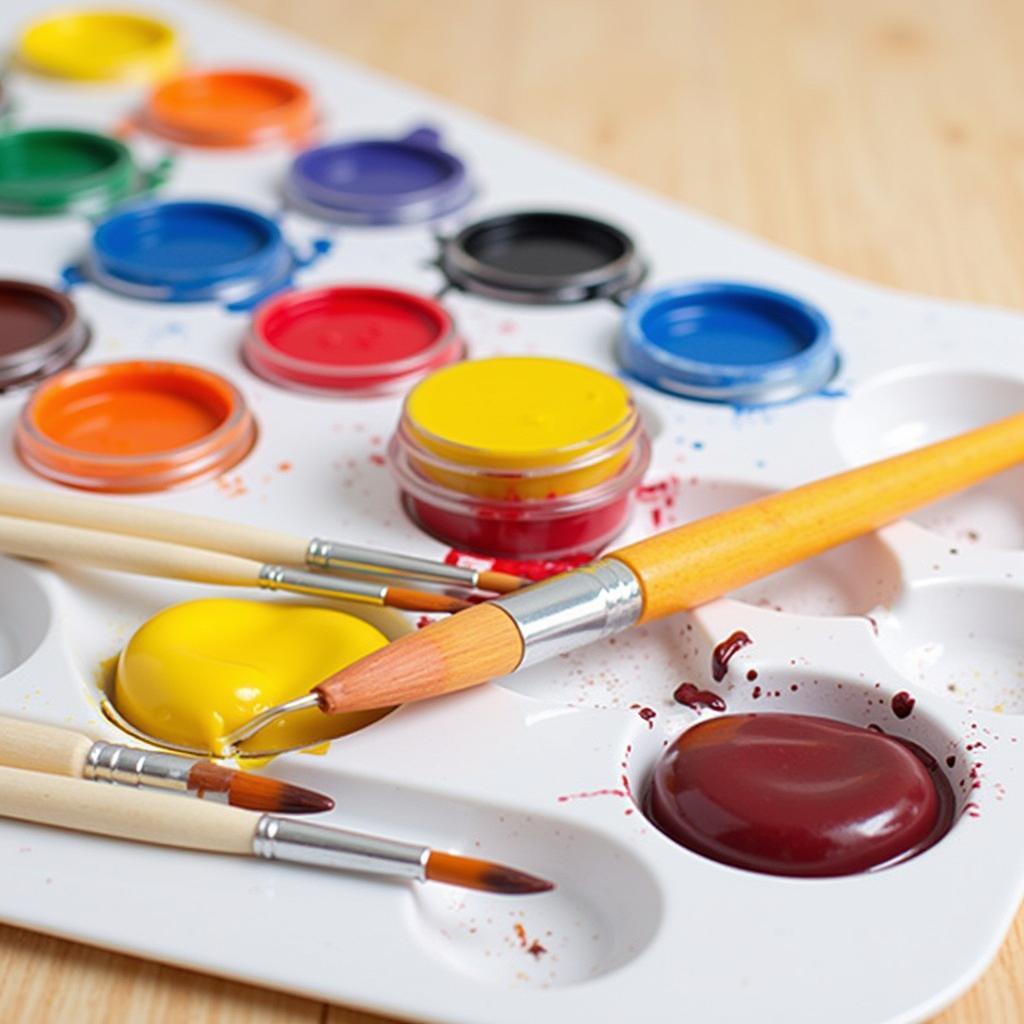Types of Paint for Art: A Comprehensive Guide
Choosing the right paint can be the cornerstone of any artistic endeavor. Whether you’re a seasoned artist or just starting your creative journey, understanding the different Types Of Paint For Art is crucial for achieving your desired effects and ensuring the longevity of your work. This guide will delve into the diverse world of artistic paints, exploring their unique properties, advantages, and ideal applications. Let’s embark on this colorful exploration together!
After selecting your paints, you may need more supplies. Check out our curated online art supplies store.
Exploring Acrylics: Versatile and Vibrant
Acrylic paints are known for their versatility and quick drying time. They are water-based, making them easy to clean up and ideal for beginners. Acrylics can be used on a variety of surfaces, including canvas, paper, wood, and fabric. Their vibrant colors and ability to mimic both watercolor and oil paint effects make them a popular choice among artists of all levels.
What are the best surfaces for acrylic paints? Acrylics adhere well to primed canvases, wood panels, and even paper. Their versatility extends to fabrics and murals as well.
Unveiling the Richness of Oil Paints
Oil paints, prized for their rich colors and smooth blending capabilities, have been a staple in the art world for centuries. Their slow drying time allows for extensive blending and layering, enabling artists to create intricate details and subtle transitions. While oil paints require specific solvents for cleaning, their luminosity and depth of color are unparalleled.
How long do oil paints take to dry? Oil paints can take anywhere from a few days to several months to fully dry, depending on the thickness of the application and environmental factors.
 Oil Paints, Brushes, Canvas and Palette
Oil Paints, Brushes, Canvas and Palette
Watercolor Wonders: Transparency and Light
Watercolor paints, known for their transparency and delicate washes, create a unique ethereal quality. Their ability to be layered and blended allows for a wide range of effects, from soft washes to vibrant splashes of color. Watercolors are perfect for capturing the nuances of light and shadow, making them ideal for landscapes and portraits.
What kind of paper is best for watercolors? Watercolor paper is specifically designed to absorb water without buckling or warping, ensuring your artwork remains pristine.
Gouache: The Opaque Cousin of Watercolor
Gouache is similar to watercolor but with the addition of chalk, making it opaque. This opacity allows for vibrant, flat colors and excellent coverage. Gouache can be rewetted and reworked, offering flexibility and control. Its matte finish and bold colors make it a popular choice for illustration and design work.
Can gouache be mixed with watercolor? Yes, gouache can be mixed with watercolor to create interesting textures and variations in opacity.
The Allure of Tempera: A Classic Medium
Tempera paint, a fast-drying medium made with pigments mixed with egg yolk or other binders, has a long and rich history. Its vibrant colors and matte finish create a unique aesthetic. Tempera is known for its durability and archival qualities, making it a preferred choice for murals and frescoes.
What is the difference between tempera and acrylic paint? While both are water-based, tempera has a distinct matte finish and dries much faster than acrylics. Acrylics offer greater flexibility in terms of blending and layering.
 Tempera Paint Set, Brushes, and Palette
Tempera Paint Set, Brushes, and Palette
Delving into Digital Painting: Expanding Artistic Horizons
Digital painting uses software and electronic devices to create artwork. It offers a wide range of tools and effects, allowing for unparalleled experimentation and manipulation of images. Digital painting provides artists with the flexibility to undo mistakes, experiment with different styles, and easily share their work online.
What are the benefits of digital painting? Digital painting offers unparalleled control, allowing artists to easily edit and refine their work. It also eliminates the need for physical materials, making it a more sustainable option.
Choosing Your Paint: Finding the Perfect Fit
Selecting the right type of paint depends on your artistic goals, preferred style, and desired effects. Each medium offers unique characteristics and possibilities. Experimenting with different types of paint is encouraged to discover which best suits your creative vision. You can find various types of paints for art at specialized stores.
Conclusion
Understanding the different types of paint for art is essential for any artist seeking to expand their creative horizons. From the versatile nature of acrylics to the richness of oil paints, the transparency of watercolors, the opacity of gouache, the classic appeal of tempera, and the innovative possibilities of digital painting, each medium offers a unique path to artistic expression. Choosing the right paint can elevate your artwork and empower you to bring your artistic vision to life. Don’t forget to check out our guide for advanced art supplies when you are ready to take the next step. Explore, experiment, and discover the endless possibilities that await you in the world of artistic paints! Also, if you are in the area, check out the exciting Hilton Head Island art festival. You might discover new inspiration and types of paint!
FAQ
- What is the easiest type of paint to use for beginners? Acrylics are generally considered the easiest paint for beginners due to their water-based nature and quick drying time.
- What type of paint is best for detailed work? Oil paints are excellent for detailed work due to their slow drying time, which allows for extensive blending and layering.
- What type of paint is best for landscapes? Watercolors are well-suited for landscapes because of their transparency and ability to capture the nuances of light and shadow.
- What is the difference between gouache and watercolor? Gouache is opaque, while watercolor is transparent.
- What type of paint is known for its archival qualities? Tempera is known for its durability and archival qualities.
If you need help with diamond painting, check out our article on diamond sticker art.
What are some common scenarios where questions about types of paint arise? Often, artists beginning a new project or exploring a new medium will have questions about the different types of paint available. Students in art classes often need clarification on the properties of various paints.
What are some other related questions or topics that might be helpful? It might be helpful to explore topics like paintbrushes, canvases, palettes, and other art supplies. Learning about color theory, mixing techniques, and different painting styles could also be beneficial.
When you need support, please contact us by Phone: 02462573573, Email: danteum@gmail.com or visit us at Savico Megamall, 7-9 Đ. Nguyễn Văn Linh, Gia Thụy, Long Biên, Hà Nội 10000, Việt Nam. We have a 24/7 customer support team.


